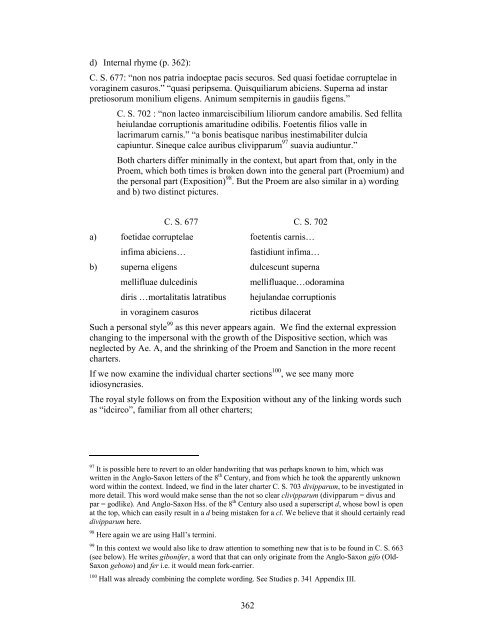Provisional Drogereit pdf
Provisional Drogereit pdf
Provisional Drogereit pdf
You also want an ePaper? Increase the reach of your titles
YUMPU automatically turns print PDFs into web optimized ePapers that Google loves.
d) Internal rhyme (p. 362):<br />
C. S. 677: “non nos patria indoeptae pacis securos. Sed quasi foetidae corruptelae in<br />
voraginem casuros.” “quasi peripsema. Quisquiliarum abiciens. Superna ad instar<br />
pretiosorum monilium eligens. Animum sempiternis in gaudiis figens.”<br />
C. S. 702 : “non lacteo inmarciscibilium liliorum candore amabilis. Sed fellita<br />
heiulandae corruptionis amaritudine odibilis. Foetentis filios valle in<br />
lacrimarum carnis.” “a bonis beatisque naribus inestimabiliter dulcia<br />
capiuntur. Sineque calce auribus clivipparum 97 suavia audiuntur.”<br />
Both charters differ minimally in the context, but apart from that, only in the<br />
Proem, which both times is broken down into the general part (Proemium) and<br />
the personal part (Exposition) 98 . But the Proem are also similar in a) wording<br />
and b) two distinct pictures.<br />
C. S. 677 C. S. 702<br />
a) foetidae corruptelae<br />
foetentis carnis…<br />
infima abiciens…<br />
fastidiunt infima…<br />
b) superna eligens<br />
dulcescunt superna<br />
mellifluae dulcedinis<br />
mellifluaque…odoramina<br />
diris …mortalitatis latratibus hejulandae corruptionis<br />
in voraginem casuros<br />
rictibus dilacerat<br />
Such a personal style 99 as this never appears again. We find the external expression<br />
changing to the impersonal with the growth of the Dispositive section, which was<br />
neglected by Ae. A, and the shrinking of the Proem and Sanction in the more recent<br />
charters.<br />
If we now examine the individual charter sections 100 , we see many more<br />
idiosyncrasies.<br />
The royal style follows on from the Exposition without any of the linking words such<br />
as “idcirco”, familiar from all other charters;<br />
97 It is possible here to revert to an older handwriting that was perhaps known to him, which was<br />
written in the Anglo-Saxon letters of the 8 th Century, and from which he took the apparently unknown<br />
word within the context. Indeed, we find in the later charter C. S. 703 divipparum, to be investigated in<br />
more detail. This word would make sense than the not so clear clivipparum (divipparum = divus and<br />
par = godlike). And Anglo-Saxon Hss. of the 8 th Century also used a superscript d, whose bowl is open<br />
at the top, which can easily result in a d being mistaken for a cl. We believe that it should certainly read<br />
divipparum here.<br />
98 Here again we are using Hall’s termini.<br />
99 In this context we would also like to draw attention to something new that is to be found in C. S. 663<br />
(see below). He writes gibonifer, a word that that can only originate from the Anglo-Saxon gifo (Old-<br />
Saxon gebono) and fer i.e. it would mean fork-carrier.<br />
100 Hall was already combining the complete wording. See Studies p. 341 Appendix III.<br />
362
















